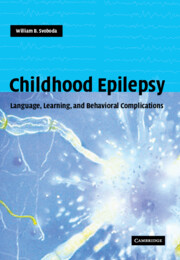Book contents
- Frontmatter
- Contents
- Preface
- Glossary
- 1 Looking ahead
- Part I Speech and language problems
- Part II Learning problems
- Part III Behavior problems
- 27 Mental health needs
- 28 Psychologic development
- 29 Seizure types and modifying factors
- 30 Overview: extrinsic factors
- 31 Behavior problems: general
- 32 Attention deficit disorders
- 33 Anxiety disorders
- 34 Mood disorders
- 35 Disruptive behavior problems
- 36 Psychoses of epilepsy
- 37 Non-epileptic events
- 38 Possible treatment issues
- 39 Helping with psychiatric problems
- 40 Epilog
- Index
- References
35 - Disruptive behavior problems
from Part III - Behavior problems
Published online by Cambridge University Press: 26 October 2009
- Frontmatter
- Contents
- Preface
- Glossary
- 1 Looking ahead
- Part I Speech and language problems
- Part II Learning problems
- Part III Behavior problems
- 27 Mental health needs
- 28 Psychologic development
- 29 Seizure types and modifying factors
- 30 Overview: extrinsic factors
- 31 Behavior problems: general
- 32 Attention deficit disorders
- 33 Anxiety disorders
- 34 Mood disorders
- 35 Disruptive behavior problems
- 36 Psychoses of epilepsy
- 37 Non-epileptic events
- 38 Possible treatment issues
- 39 Helping with psychiatric problems
- 40 Epilog
- Index
- References
Summary
Behavior disorders occur in 28.6% of children with uncomplicated seizures and in 58.3% of children with seizures and other brain dysfunctions, according to parent and teacher reports (Dunn & Austin, 1998). Children struggling with the problem of epilepsy often display acting-out behaviors. They may seem moody or they may display erratic, variable, unpredictable behaviors. Some children seem irritable, exhibiting angry outbursts of temper. Their attention spans may seem shortened. Some children are anxious and jittery, with hyperactive behavior.
Rebellious, resentful attitude
The child, especially in adolescence, may try to escape from the parents' overly restrictive demands through rebellion. Some children may be so discouraged that they lash out angrily. Some may try to blame others for rejecting them because of the seizures. They seem angry, hostile, and aggressive. The school record may be one of absenteeism. Some may develop frank antisocial and delinquent behavior. Such children need intensive guidance and counseling so that they may finally accept the epilepsy and develop a better self-concept and therefore move ahead.
Impulse-control problems
Over the years, impulse-control problems have emerged with a variety of names, including episodic dyscontrol syndrome, intermittent explosive disorder, and “rage” reactions. Impulse-control problems may be seen in personality disorders, with cerebral damage as with seizure activity, structural loss, antiepileptic drugs, and social deprivation.
The possibility of an ictal basis for aggressive symptoms as part of the interictal period, in which aggressive behavior may follow one or more serial unrecognized seizures, is debated.
- Type
- Chapter
- Information
- Childhood EpilepsyLanguage, Learning and Behavioural Complications, pp. 533 - 546Publisher: Cambridge University PressPrint publication year: 2004
References
- 1
- Cited by



